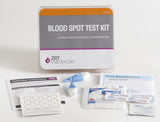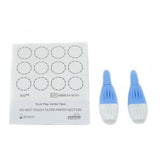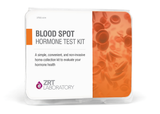The Insulin Test Kit (In) (Fasting ) is a comprehensive solution designed to assess insulin levels in the body accurately. This test kit is specifically formulated to determine the cause of low blood glucose (hypoglycemia), diagnose an insulinoma, and evaluate insulin production.
Key Features:
- Accurate Insulin Level Assessment: The test kit provides accurate measurements of insulin levels, allowing for a precise understanding of insulin production and functioning in the body.
- Indicator of Insulin Resistance: High fasting insulin levels are a reliable indicator of insulin resistance, regardless of whether the patient shows glucose intolerance. Insulin resistance occurs when the body's response to insulin is impaired, resulting in reduced glucose uptake by tissues for energy production. Chronically high insulin levels are often observed as the body attempts to regulate blood sugar levels. The normal range for fasting insulin is 1 – 15 μIU/mL, but levels between 1 and 8 μIU/mL are optimal.
- Comprehensive Evaluation: The test kit helps diagnose insulinoma and evaluate insulin production. It provides valuable insights into the functioning of the pancreatic beta cells, assisting in identifying potential issues related to insulin regulation.
- Fasting Insulin Assessment: The test is for the assessment of insulin level. This information is crucial in tracking diabetes progression and assessing cardiovascular disease risk.
- Convenient and At-Home Testing: With the ability to collect samples from the comfort of your own home, the Insulin Fasting Test Kit offers convenience and privacy. Simply collect the samples within 1 hour waking of the day and send them to our lab for analysis.
- Detailed Test Result Analysis: Once the laboratory receives your samples, you can expect to receive your test result within 3-5 working days. The result will provide your hormone levels in both graphical and numerical formats. Additionally, a Hormone Specialist PhD Doctor will provide detailed comments and analysis of your hormone levels, guiding you on the next steps to take.
- No Additional Laboratory Costs: The test kit includes a laboratory fee, ensuring that there are no additional costs or taxes for laboratory analysis.
- The test kit should be used within 12 months from the purchase date.
- Customers are responsible for shipping their samples to the laboratory.
High fasting insulin levels serve as a valuable indicator of insulin resistance, regardless of whether the patient exhibits glucose intolerance. Insulin resistance occurs when the body's cells do not respond effectively to insulin, leading to reduced glucose uptake for energy production by the tissues. As a result, the body compensates by maintaining chronically high insulin levels in an attempt to regulate blood sugar levels. The normal range for fasting insulin is typically between 1 and 15 μIU/mL, with optimal levels falling between 1 and 8 μIU/mL.
These insights into fasting levels provide valuable information for assessing insulin resistance, monitoring diabetes progression, and evaluating cardiovascular disease risk. Regular monitoring of insulin levels can aid in early detection and proactive management of these conditions, enabling individuals to take control of their health and make informed decisions regarding their well-being.
High levels of Insulin symptoms:
High levels of insulin in the body can manifest in various symptoms that indicate potential insulin resistance or other metabolic imbalances. It's important to note that these symptoms may not be exclusive to high insulin levels and can also be associated with other conditions. Here are some common symptoms associated with high levels of insulin:
- Extreme thirst or hunger: Individuals with high insulin levels may experience an increased feeling of thirst or persistent hunger, even after consuming a meal.
- Feeling hungry even after a meal: Despite eating, individuals with high insulin levels may still feel hungry or experience frequent food cravings.
- Increased or frequent urination: High insulin levels can affect kidney function, leading to increased urine production and more frequent trips to the restroom.
- Tingling sensations in hands or feet: Prolonged high insulin levels may contribute to nerve damage or peripheral neuropathy, resulting in tingling or numbness in the hands or feet.
- Feeling more tired than usual: High insulin levels can disrupt energy metabolism and lead to feelings of fatigue, even with sufficient rest.
- Frequent infections: Insulin plays a role in immune system regulation, and persistently high levels can compromise immune function, making individuals more susceptible to frequent infections.
- Evidence of high blood sugar levels in blood work: Elevated insulin levels are often associated with high blood sugar levels (hyperglycemia). Blood work that indicates consistently elevated blood sugar levels may suggest high insulin levels as well.
The Benefit of Insulin Fasting Dried Blood Spot Test
The laboratory-based dried blood spot insulin test offers several benefits in the assessment of insulin levels and related conditions. Here are some advantages of this testing method:
- Convenient and Minimally Invasive: Dried blood spot (DBS) testing involves a simple finger prick to collect a small blood sample on a filter paper. It is a minimally invasive technique that can be easily performed at home or in a clinical setting without the need for venous blood draws. This convenience reduces the discomfort and anxiety associated with traditional blood collection methods.
- Stable Sample Collection and Storage: Once the blood droplet is collected on the filter paper, it is allowed to dry. The dried blood spot samples are highly stable and can withstand variations in temperature during transportation. This stability eliminates the need for immediate sample processing or refrigeration, making it suitable for remote areas or situations where access to healthcare facilities is limited.
- Cost-Effective: Laboratory-based dried blood spot testing offers cost savings compared to traditional venous blood collection methods. It requires fewer supplies and eliminates the need for specialized equipment, reducing the overall cost of the test. This affordability enhances accessibility for individuals seeking insulin level assessment.
- Comprehensive Analysis: Dried blood spot samples can be used to measure various analytes, including insulin. This comprehensive analysis allows for a more holistic assessment of metabolic health, including insulin resistance and related conditions.
- Accurate and Reliable Results: Laboratory-based dried blood spot testing utilizes advanced laboratory techniques to analyze the dried blood samples. These methods have been extensively validated and proven to provide accurate and reliable results, ensuring confidence in the diagnostic information obtained.
- Monitoring and Tracking: Dried blood spot testing can be used for regular monitoring and tracking of insulin levels over time. This longitudinal data helps healthcare professionals assess the effectiveness of treatment plans and make necessary adjustments to manage insulin resistance or related conditions.
Laboratory-based dried blood spot insulin testing offers a convenient, cost-effective, and reliable method for assessing insulin levels and monitoring metabolic health. It empowers individuals and healthcare providers with valuable insights into insulin resistance, facilitating appropriate interventions and personalized treatment approaches.
What is Insulin and The Function of Insulin
Insulin is a hormone produced by the beta cells of the pancreas, specifically in the islets of Langerhans. It plays a vital role in regulating glucose metabolism and maintaining normal blood sugar levels. Here are the main functions of insulin:
- Glucose Regulation: Insulin helps regulate the amount of glucose (sugar) in the bloodstream. When we consume carbohydrates, they are broken down into glucose, which enters the bloodstream. Insulin facilitates the uptake of glucose from the bloodstream into the cells, particularly in muscle, fat, and liver cells. It promotes the conversion of glucose into energy or storage as glycogen (in the liver and muscles) for later use.
- Facilitating Cellular Uptake: Insulin acts as a "key" that unlocks the cells, allowing glucose to enter. It binds to specific insulin receptors on the cell surface, triggering a signalling cascade that promotes the transport of glucose molecules into the cells. This process ensures that cells have the necessary energy to function optimally.
- Inhibiting Glucose Production: Insulin also suppresses the production of glucose in the liver. It reduces the breakdown of glycogen stored in the liver and inhibits the release of glucose into the bloodstream, preventing excessive elevation of blood sugar levels.
- Protein and Fat Metabolism: Insulin plays a role in protein synthesis and regulates amino acid uptake into cells, promoting the building and repair of tissues. It also helps in the storage of fats (lipids) by enhancing the uptake of fatty acids into fat cells and inhibiting the breakdown of stored fats.
- Appetite Regulation: Insulin helps regulate appetite and satiety. When insulin levels are elevated after a meal, it sends signals to the brain, signalling a feeling of fullness and reducing appetite.
- Regulation of Other Hormones: Insulin influences the actions of several other hormones in the body. For example, it inhibits the release of glucagon, another pancreatic hormone that raises blood sugar levels. Insulin also affects the production and release of hormones such as growth hormone and cortisol.
Insulin is essential for maintaining normal blood sugar levels and facilitating the proper functioning of cells throughout the body. When insulin production or function is impaired, it can lead to conditions like insulin resistance, type 2 diabetes, and metabolic disorders. Managing insulin levels and sensitivity is crucial for overall metabolic health.
How to Use












